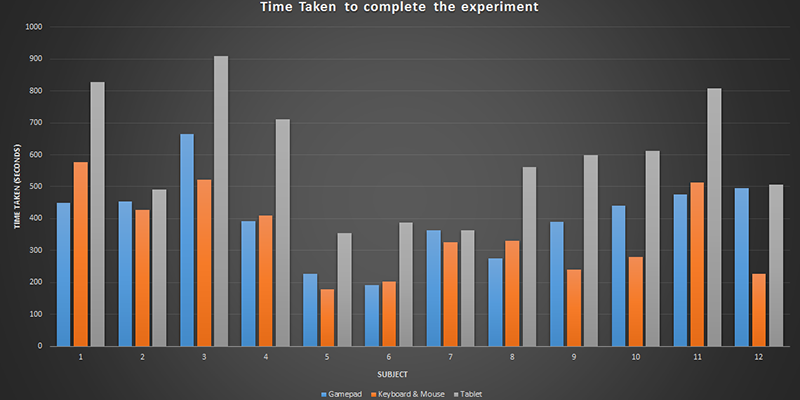
The Conclusion
With the data that we have collected from our experiment we have been able to form some conclusions to the effects that different controllers make on movement and coordination in a 3D environment.
It is quite apparent from the results that the different controller types can create a noticeable difference between each other, when trying to perform a task in a 3D environment. This is shown by the consistent differences in time when using specific controllers. The Keyboard and mouse was almost always the best, with the gamepad coming second and the tablet taking the longest. This is shown by the differences in the mean and median values of the results, which show the tablet taking considerately longer than the other two control schemes.
The method that was employed in the experiment was to the best of its abilities able to prevent bias from the order that the controllers were used, as the number of different orders and samples taken seem to have cancelled out any obvious bias that could have occurred. If this experiment was replicated using the methodology that was employed the results would be easily replicated
The preferences that the participants had did not really change a great deal. Most of them started preferring the mouse and keyboard, however almost all of the participants that preferred the gamepad changed their mind to the keyboard and mouse after using it.
The big thing that has been shown in this experiment is that the tablet was almost universally disliked. There was a section for feedback on the questionnaires about the controller types, which led to the mouse and keyboard receiving comments like “ease of control”, or “mouse too sensitive for precise movements” showing that whilst liked, it could've been better.
This is the same with the gamepad with comments such as “Controller was more comfortable (ergonomic)”, and “easy to use however it was a bit sluggish”. The tablet however was not liked and received comments such as “awkward to move around”, and “hard to navigate” it even received a comment that included some ‘colourful’ language describing it. It was not just negative since some favourable comments such as “able to tap on the whole screen is a plus” were received from the participants.
In conclusion it was found, and can be summarized with the graphs created from collected data that different types of controller do have a large impact on movement and coordination in a 3D environment and that the hypothesis was correct.
